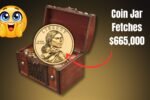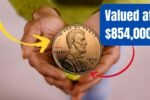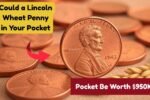Hey there! Have you ever looked closely at the cash in your wallet? Most of us don’t think twice about the bills we carry, but what if I told you that a simple $10 bill could be worth a fortune? Yup, you heard that right! There’s a rare $10 bill with a special serial number pattern called a “serial repeater” that could fetch up to $410,000. So, grab your wallet, and let’s dive into this treasure hunt to see if you’re holding a hidden gem!
What’s a Serial Repeater, Anyway?
Imagine finding a $10 bill that’s not just money but a collector’s dream. A serial repeater is a bill with a serial number where the digits follow a repeating pattern. Think of numbers like 12341234 or 45454545. These patterns are super rare because the U.S. Bureau of Engraving and Printing assigns serial numbers randomly, so getting one with such a neat, repeating sequence is like finding a needle in a haystack. Collectors go wild for these bills because they’re unique, eye-catching, and oh-so-rare. A $10 bill with a perfect repeater pattern, especially in pristine condition, could be your ticket to a life-changing payday.
Why Is This $10 Bill So Valuable?
You might be wondering, why would anyone pay $410,000 for a $10 bill? It’s not just about the pattern. The value comes from a mix of rarity, condition, and history. For example, a 1934 series Federal Reserve Note with a repeater serial number, like 00010001 or 12344321, is incredibly scarce. Only a handful of these bills are known to exist, and collectors are willing to pay big bucks for them. Add to that a bill in uncirculated condition—meaning it’s crisp, clean, and has never been folded or creased—and you’ve got a collector’s holy grail. It’s like finding a rare comic book in mint condition; the better it looks, the more it’s worth!
How to Spot the Golden $10 Bill
Ready to check your cash? Here’s what to look for. First, find the serial number on your $10 bill—it’s usually printed in green ink on the right side. Look for a repeating pattern, like 12121212 or 56565656. The more perfect the repeat, the better! Next, check the condition. Is the bill crisp and clean, or does it look like it’s been through a washing machine? Uncirculated bills are worth way more. Also, keep an eye out for the series year, like 1934, and any star symbols, which mark replacement notes and can add value. It’s like being a detective, searching for clues that could lead to a fortune.
Could It Really Be in Your Wallet?
Here’s the exciting part: these rare bills might still be out there! They were printed and circulated through regular channels like banks, ATMs, or even the change you got at the grocery store. Most people don’t check serial numbers, so a $410,000 bill could be sitting in your wallet right now, disguised as pocket change. Stories of rare bills turning up in unexpected places—like old drawers or garage sales—are what keep collectors buzzing. It’s like finding a winning lottery ticket you didn’t know you had. So, next time you get a $10 bill, take a second to inspect it. You never know what you might find!
Tips to Protect and Cash In on Your Find
Found a bill that looks promising? Don’t fold it or stuff it back in your pocket! Treat it like a delicate piece of art. Store it flat in a protective sleeve to keep it in top condition. If you think you’ve got a rare repeater, get it checked by a professional currency grader, like the Paper Money Guaranty (PMG). They’ll verify its authenticity and grade its condition, which can boost its value. Then, you can sell it through a reputable auction house or a currency dealer. It’s like turning a dusty old painting into a masterpiece that collectors fight over.
Why Currency Collecting Is So Hot Right Now
Currency collecting, or numismatics, is booming. With digital payments taking over, paper money with unique features is becoming more desirable. It’s like vinyl records making a comeback—there’s something special about holding a piece of history. Social media has also fueled the craze, with collectors sharing their finds and sparking excitement. A rare $10 bill with a repeater serial isn’t just money; it’s a story, a piece of art, and a potential windfall. So, why not join the fun and start checking your bills?
Conclusion
Who knew that a humble $10 bill could be worth $410,000? The thrill of finding a rare serial repeater is like striking gold in your own wallet. By checking your cash for repeating patterns, pristine condition, and unique features, you could uncover a hidden treasure. So, next time you’re paying for coffee or digging through your change, take a moment to inspect those $10 bills. You might just be holding a fortune! Keep your eyes peeled, and happy hunting!
FAQs
What is a serial repeater on a $10 bill?
It’s a serial number where the digits repeat in a pattern, like 12341234 or 45454545, making the bill super rare and valuable.
How do I know if my $10 bill is valuable?
Check the serial number for a repeating pattern, look at the series year (like 1934), and ensure the bill is in crisp, uncirculated condition.
Where can I sell a rare $10 bill?
Try auction houses, currency dealers, or grading services like PMG to verify and sell your bill for the best price.
Are all repeater serial bills worth $410,000?
Not all! The value depends on the pattern, condition, and rarity. A 1934 bill in perfect condition is the big winner.
Can I still find these bills in circulation?
Yes! They could be in your wallet, change, or old stashes, so always check your $10 bills carefully.





